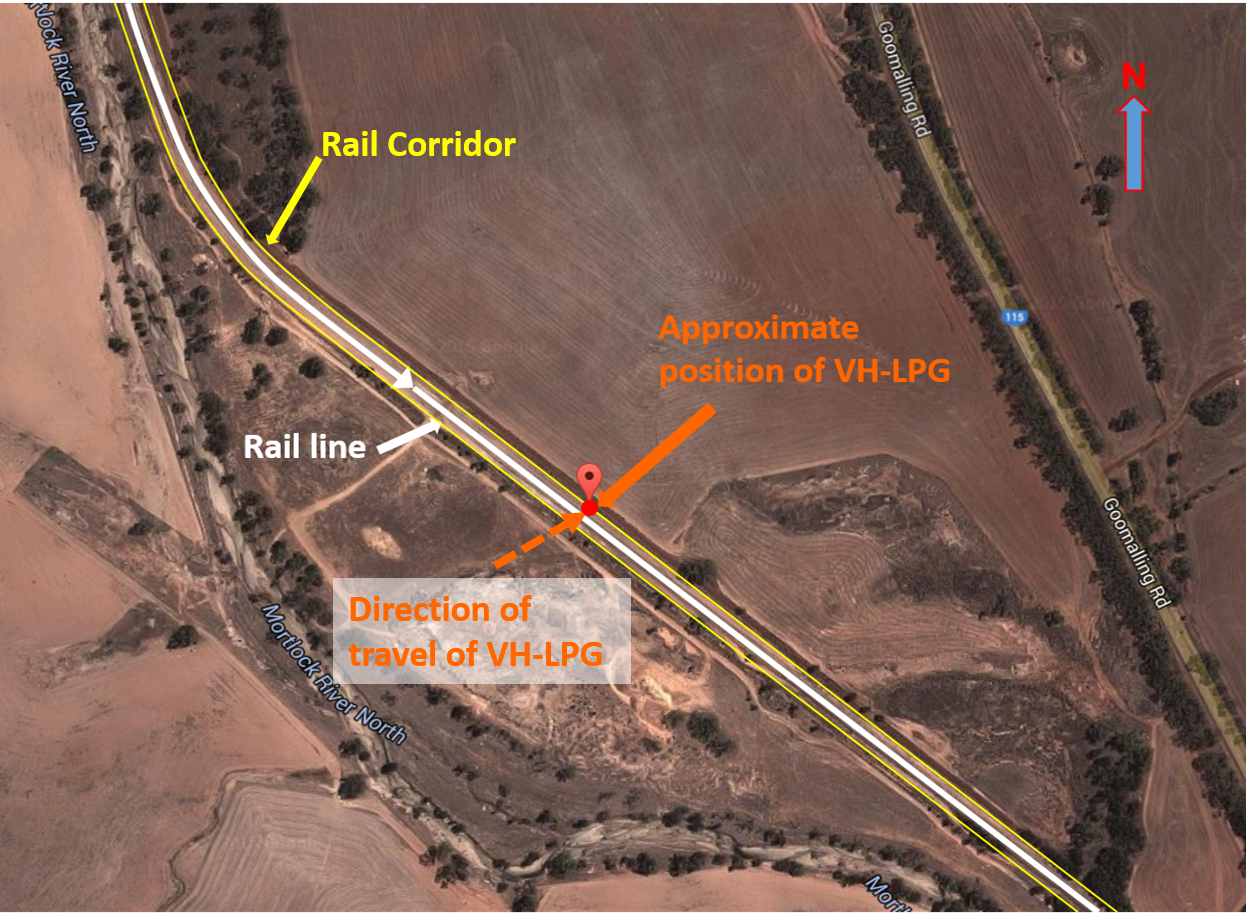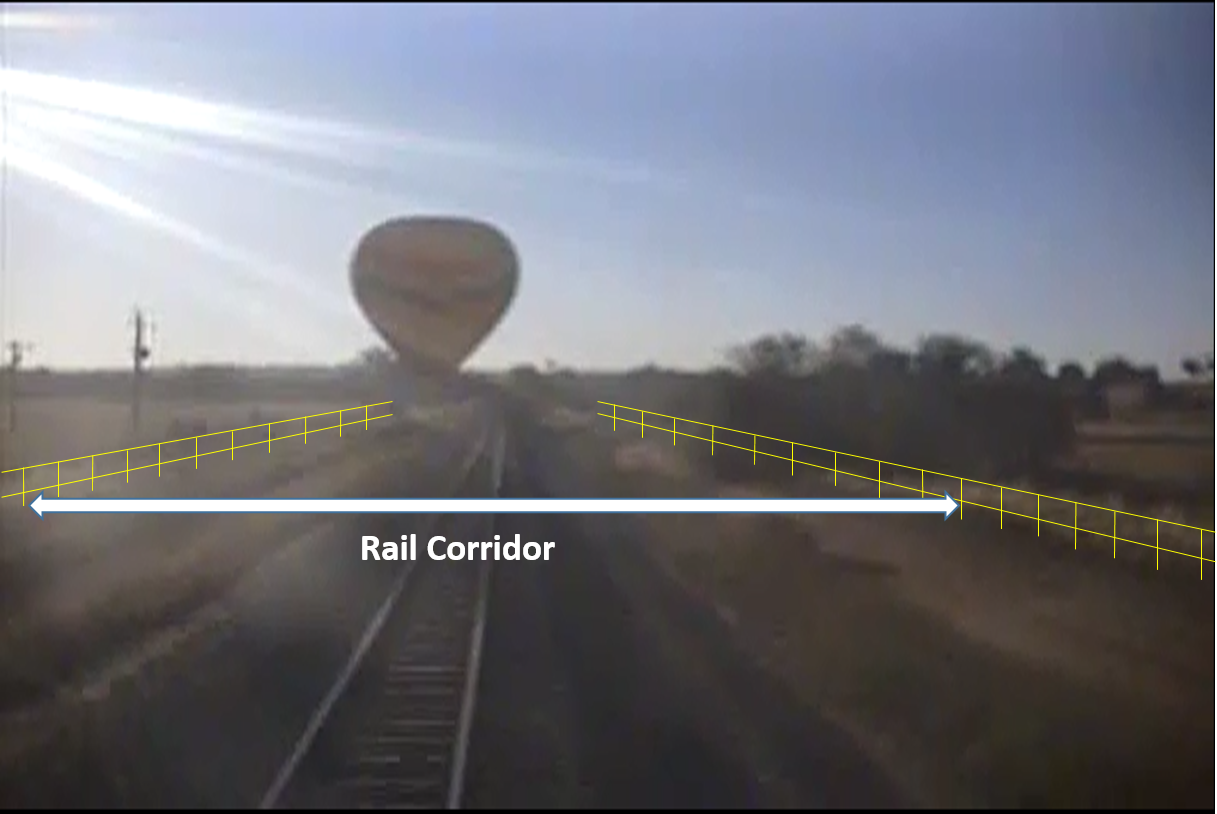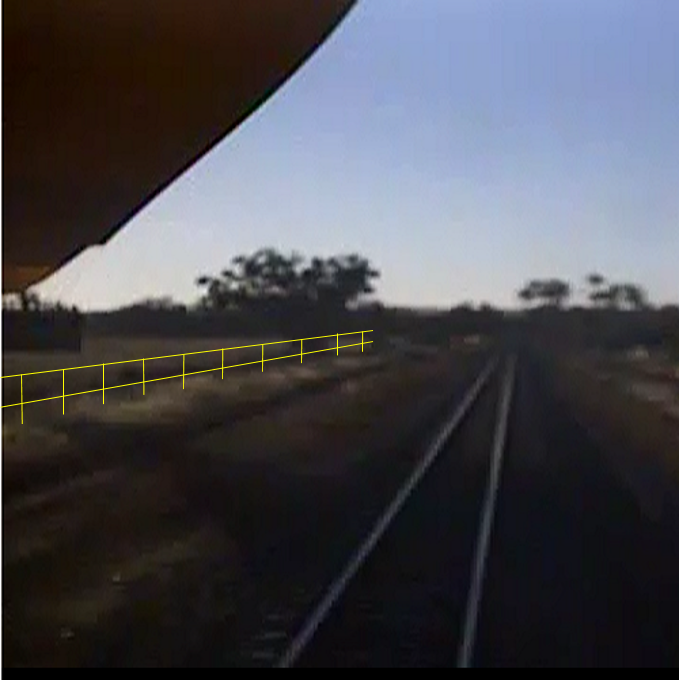What happened
Early on the morning of 11 November 2015, a Watco freight train, 4K26, was travelling southbound on the Frenches to East Northam rail line in Western Australia. The train was travelling at about 60 km/hr along a section of track as it approached a left corner, approximately 3 km north of Northam (Figure 1). As the train rounded the corner, the driver saw a hot air balloon in close proximity to the rail tracks. The driver observed that the balloon was low to the ground and inside the rail corridor,[1] to the left side of the track (Figure 2).
Figure 1: Location of incident with rail line (white) showing direction of travel of the train, the approximate width of the rail corridor (yellow), the direction of travel of the hot air balloon (orange dashed line) and the approximate position of the hot-air balloon (red mark)

Source: Google maps. Modified by ATSB
Figure 2: View from train driver’s cabin as the train rounded the corner with the approximate position of the fences (yellow) either side of the rail line marking the rail corridor

Source: Watco driver’s video, modified by ATSB
The driver estimated that the balloon was approximately 200–300 m in front of the train and applied full service brakes. However, the driver realised there would be insufficient distance for the train to come to a complete stop before passing the balloon. At the same time as applying the brakes, the driver also sounded the train’s horn to warn the balloon that the train was approaching. The driver slowed the train to about 20 km/hr as it passed the balloon.
Figure 3: Picture from the train driver’s cabin just before the train passed the balloon’s position with the approximate position of the fence on the left side (yellow)

Source: Watco driver’s video, modified by ATSB
The Kavanagh Balloons E-300, registered VH-LPG, had taken off east of Northam earlier in the morning for a scenic flight, with the pilot and 16 passengers on board. The pilot’s initial intention was to land in a paddock to the west of the rail line. However, the prevailing wind meant that this was not an option. Instead, they elected to land in the paddock east of the railway line, as the pilot judged it to be the most suitable location in the area. Also, flying to an alternative landing site may have unnecessarily impinged on fuel reserves with the prevailing winds and weather conditions on the morning.
The pilot crossed the rail line from the south-west to the north-east at a height of approximately 50–60 ft, and then descended to around fence top height. The pilot’s intention was to land inside the paddock, just after the fence line at the edge of the rail corridor. As the train came around the corner, the hot air balloon was on descent to the paddock. When the train passed the balloon, the pilot reported the basket was just above fence height and moving away from the rail tracks. The balloon crossed over the fence and landed in the paddock without incident.
Pilot comments
The pilot of the balloon made the following comments in relation to the event:
- Crops in the centre of the paddock and a powerline limited the available landing space, which meant the pilot was landing close to the fence.
- The pilot had landed in the same paddock on many occasions without problems.
- The pilot did not recall hearing the train horn or brakes until the train passed the balloon.
Train driver and observer comments
The train driver and observer made the following additional comments:
- The driver and observer saw the balloon in the distance, however due to the winding track it was not possible to see the location of the balloon relative to the track, until the train came around the bend.
- They were unable to discern the direction of travel of the balloon.
- When they saw the balloon, they believed a collision was likely.
- They suggested that an awareness of the train schedule by balloon operators may avoid a similar event.
Proactive safety action
Whether or not the ATSB identifies safety issues in the course of an investigation, relevant organisations may proactively initiate safety action in order to reduce their safety risk. The ATSB has been advised of the following proactive safety action in response to this occurrence.
Balloon operator
The balloon operator is amending the Low Flying Operations section of their Operations Manual to include the following:
A minimum height of 50 feet shall be maintained when the flight path of the balloon will cause it to cross over a road reserve or rail corridor.
Safety message
Rail corridors are areas where access is strictly controlled as the presence of non-authorised or unexpected personnel and/or vehicles may pose a danger to the safety of rail operations and personnel. Trains require significant distance to come to a complete stop and may not be able to avoid colliding with an obstruction that is on, or near, the tracks.
Operators of balloons or other aircraft that may fly at low-level in the vicinity of rail tracks should consider and minimise risks when operating in these environments.
Purpose of safety investigationsThe objective of a safety investigation is to enhance transport safety. This is done through:
It is not a function of the ATSB to apportion blame or provide a means for determining liability. At the same time, an investigation report must include factual material of sufficient weight to support the analysis and findings. At all times the ATSB endeavours to balance the use of material that could imply adverse comment with the need to properly explain what happened, and why, in a fair and unbiased manner. The ATSB does not investigate for the purpose of taking administrative, regulatory or criminal action. TerminologyAn explanation of terminology used in ATSB investigation reports is available here. This includes terms such as occurrence, contributing factor, other factor that increased risk, and safety issue. Publishing informationReleased in accordance with section 25 of the Transport Safety Investigation Act 2003 Published by: Australian Transport Safety Bureau © Commonwealth of Australia 2016
Ownership of intellectual property rights in this publication Unless otherwise noted, copyright (and any other intellectual property rights, if any) in this report publication is owned by the Commonwealth of Australia. Creative Commons licence With the exception of the Coat of Arms, ATSB logo, and photos and graphics in which a third party holds copyright, this publication is licensed under a Creative Commons Attribution 3.0 Australia licence. Creative Commons Attribution 3.0 Australia Licence is a standard form licence agreement that allows you to copy, distribute, transmit and adapt this publication provided that you attribute the work. The ATSB’s preference is that you attribute this publication (and any material sourced from it) using the following wording: Source: Australian Transport Safety Bureau Copyright in material obtained from other agencies, private individuals or organisations, belongs to those agencies, individuals or organisations. Where you wish to use their material, you will need to contact them directly. |
__________
- Rail corridor: The rail corridor is defined ‘fence line to fence line’ either side of the rail tracks. Where there is no fence line, the corridor may be defined as a specified distance either side of the outside rail of the rail track. Any person/vehicle inside the rail corridor is considered to be in close proximity to the rail tracks


